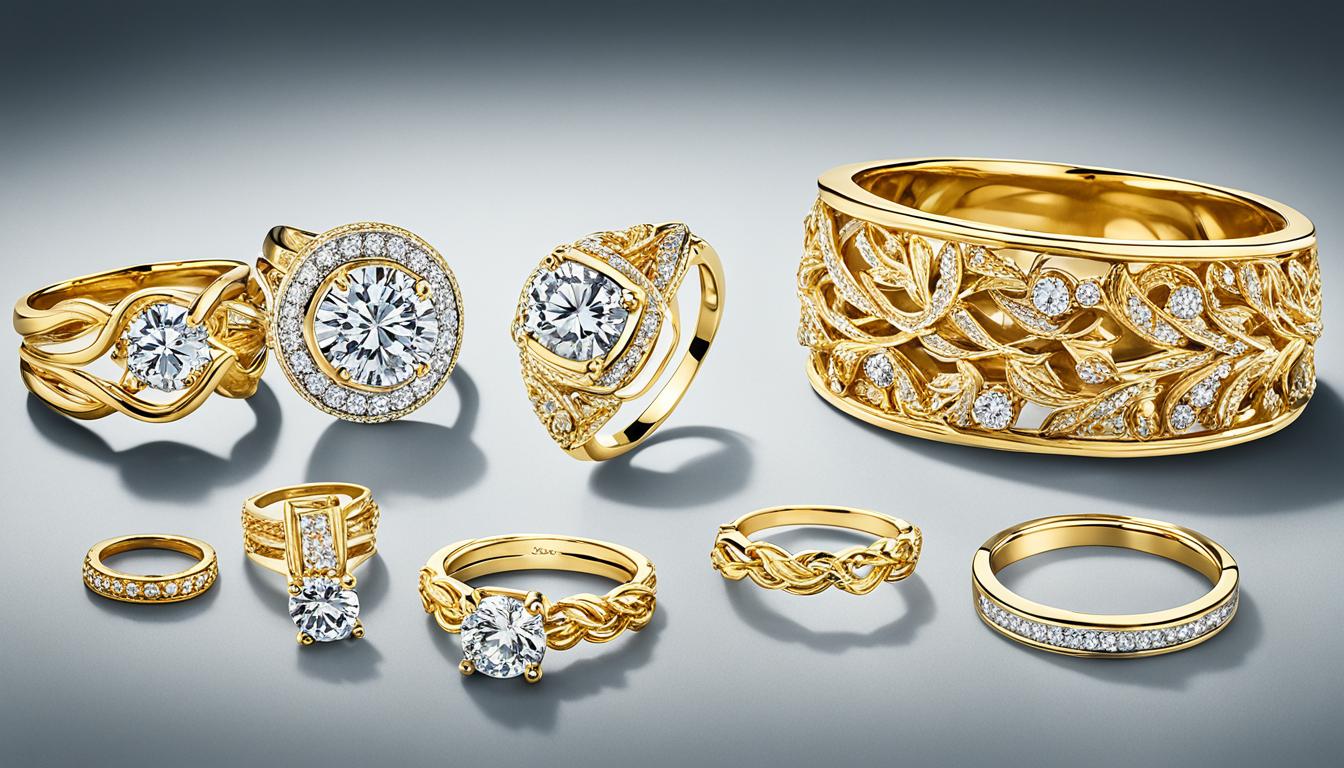Welcome to our comprehensive guide on the purity of gold and the significance of karat measurement. If you’ve ever wondered what karat is pure gold, or how to distinguish between different gold purity levels, you’ve come to the right place.
When it comes to gold, purity is of utmost importance. Pure gold, also known as 24 karat gold, is a metal that consists of 100% gold. However, pure gold is too soft to be suitable for jewelry, as it is prone to bending and scratching easily.
To increase the durability and strength of gold jewelry, it is mixed with other metals to create alloys. The karat measurement is used to determine the percentage of gold in the piece, with higher karat indicating a higher gold content. This means that a 24 karat gold piece contains 100% gold, while a 14 karat gold piece contains 58.3% gold and 41.7% of other metals.
Not only does the karat level determine the gold purity, but it also affects the color of the gold. For example, yellow gold is achieved by mixing pure gold with alloys such as copper and zinc, while white gold is created by blending pure gold with metals like silver and palladium. Rose gold, on the other hand, is a result of combining pure gold with copper.
Now, you might be wondering how karat is different from carat. While karat is a measurement of gold purity, carat is used to measure the weight of gemstones. Keep in mind that when discussing gold, the correct term is karat, not carat.
In the following sections, we will delve into the different karat levels of gold, the pros and cons of each, and guide you in choosing the right karat for your gold jewelry. Let’s explore the world of gold purity together.
The Different Karat Levels of Gold
Gold jewelry comes in various karat levels, each representing the percentage of gold in the alloy. Understanding these different karat levels is essential for making an informed decision when purchasing gold jewelry.
9k Gold
In the gold grading system, 9k gold is the lowest karat level commonly found in jewelry. It contains 37.5% gold and 62.5% other metals, such as copper, silver, or zinc. This composition allows for a more durable piece of jewelry while still retaining the classic gold appearance. 9k gold is an affordable option for those on a budget.
10k Gold
With a slightly higher gold content, 10k gold consists of 41.7% gold and 58.3% other metals. It is a popular choice in the United States due to its durability and affordability. 10k gold offers greater resistance to wear and tear, making it suitable for everyday wear.
14k Gold
Considered a standard karat for jewelry in many countries, 14k gold contains 58.3% gold and 41.7% other metals. This karat level strikes a balance between durability and gold purity. 14k gold offers both attractive color and strength, making it a versatile choice for a wide range of jewelry pieces.
18k Gold
Featuring a higher gold content, 18k gold is composed of 75% gold and 25% other metals. Its higher purity results in a richer and deeper color compared to lower karat levels. However, the increased gold content also makes 18k gold softer and more prone to scratches. This karat level is often chosen for fine jewelry pieces.
24k Gold
Known as pure gold, 24k gold consists of 100% gold and does not contain any other metals. It is the highest karat level and has a vibrant yellow color. However, due to its softness, 24k gold is not ideal for everyday jewelry. It is commonly used for investment purposes and in specialized jewelry pieces.
The karat measurement not only indicates the gold content but also affects the color and durability of gold jewelry. Higher karat levels like 18k and 24k offer a more luxurious and pure appearance, while lower karat levels like 9k and 10k provide greater durability and affordability. Understanding the different karat levels enables you to make an informed choice that aligns with your preferences and budget.

Pros and Cons of Different Karat Levels
When it comes to gold jewelry, each karat level has its own set of advantages and disadvantages. Understanding these factors can help you make an informed decision when choosing the right karat level for your jewelry.
Higher Karat Levels: 18k and 24k
Higher karat levels, such as 18k and 24k, offer a higher gold purity, making them more valuable and luxurious. The allure of these karat levels lies in their rich and deep hue, reflecting the true beauty of gold. However, it’s important to note that higher karat levels are also softer and more prone to scratches and damage. This can affect the durability of the jewelry and may require extra care to maintain its pristine condition.
Lower Karat Levels: 9k and 10k
Lower karat levels, such as 9k and 10k, are more durable due to their higher alloy content. While these karat levels may have a lower gold percentage and value, they offer a more budget-friendly option without compromising on style and elegance. The color of lower karat gold may appear slightly paler compared to higher karat levels, but this can also cater to individual preferences and create a unique look.
It’s important to understand that the choice of karat level also depends on the intended use of the jewelry. Higher karat levels are often preferred for special occasions and statement pieces, while lower karat levels are suitable for everyday wear and more robust designs.
The Impact on Design Options and Pricing
Different karat levels also open up a variety of design options for gold jewelry. Higher karat levels allow for intricate and detailed designs, as the softer gold can be easily shaped and molded. On the other hand, lower karat levels may limit the complexity of design due to the presence of alloys.
Price is another aspect to consider when choosing the karat level for your gold jewelry. Higher karat levels tend to be more expensive due to their higher gold purity, whereas lower karat levels offer a more affordable option without compromising on style and elegance.
Overall, the choice of karat level depends on a combination of personal preferences, budget considerations, durability requirements, color preferences, and design options. By considering these factors, you can make an informed decision that aligns with your style, needs, and budget.

Choosing the Right Karat for Your Gold Jewelry
When it comes to selecting the perfect karat for your gold jewelry, several factors should be considered, including your budget and personal preferences. The karat level determines the percentage of gold in the jewelry piece, as well as its durability, color, and price.
Higher karat levels, such as 18k and 24k, offer a luxurious choice but are accompanied by a higher price tag. These karat levels contain a higher percentage of pure gold, making them more valuable and exquisite. However, it’s important to note that higher karat gold is softer and more prone to scratches, which may affect the longevity of your jewelry.
On the other hand, lower karat levels like 9k and 10k present a more budget-friendly option without compromising the beauty of gold. These karat levels consist of a smaller percentage of gold and a higher amount of alloy metals, making the jewelry more durable while still retaining the elegance of gold.
Ultimately, the choice of karat should align with your personal preference and financial considerations. Additionally, it’s crucial to consider the intended use of the jewelry piece. For everyday wear, lower karat levels may be more practical due to their durability. However, for special occasions or investment purposes, higher karat levels can be a splendid choice.
Investment in gold jewelry should also be taken into account. Higher karat gold often retains its value over time and may serve as a potential investment. However, it’s essential to consult with a reputable jeweler or financial advisor to make informed decisions based on your individual circumstances and market conditions.
Remember, choosing the right karat for your gold jewelry is a decision that should reflect your personal style, budget, and long-term aspirations. Embrace the allure of gold in a karat level that suits your individual needs and preferences.

Conclusion
Understanding the different karat levels of gold is crucial when selecting the perfect gold jewelry. The karat measurement plays a significant role in determining the purity of gold and influences factors such as durability, color, and price. Opting for higher karat levels implies a higher gold purity, lending an exquisite and luxurious touch to your jewelry. However, it is essential to note that higher karats also result in softer gold that is more susceptible to scratches and wear.
On the other hand, lower karat levels offer a more budget-friendly option while still maintaining the inherent beauty of gold. These karat levels strike a balance between value and durability, making them suitable for everyday wear jewelry. Additionally, different karat levels present a diverse range of design options, allowing you to find the ideal gold piece that complements your personal style.
When making a decision regarding the karat level for your gold jewelry, consider your preferences, budget, and the intended usage of the piece. While the allure of 24k gold is undeniable, it is prudent to take practicality and long-term value into account. Explore the world of gold purity levels and karat selection to discover the perfect balance of aesthetic appeal and practicality for your valuable jewelry collection.
FAQ
What is pure gold?
Pure gold, also known as 24 karat gold, is a metal that contains 100% gold. However, it is too soft for jewelry, so it is mixed with other metals to create alloys.
What is the difference between karat and carat?
Karat is a measurement used to determine the percentage of gold in jewelry, while carat refers to the weight of gemstones.
What are the different karat levels of gold?
Gold jewelry is available in different karat levels, such as 9k, 10k, 14k, 18k, and 24k. Each karat level represents a different percentage of gold in the jewelry.
How does the karat level affect the color of gold?
The karat level of gold can affect its color. Higher karat levels often have a richer and deeper hue, while lower karat levels may have a slightly lighter color.
What are the pros and cons of different karat levels?
Higher karat levels like 18k and 24k offer a higher gold purity, making them more valuable and luxurious. However, they are also softer and more prone to scratches. Lower karat levels like 9k and 10k are more durable but have a lower gold percentage and value.
How do I choose the right karat for my gold jewelry?
When choosing the karat for your gold jewelry, consider your budget and preferences. Higher karat levels like 18k and 24k can be a luxurious choice but may come with a higher price tag. Lower karat levels like 9k and 10k offer a more budget-friendly option while still providing the beauty of gold.




